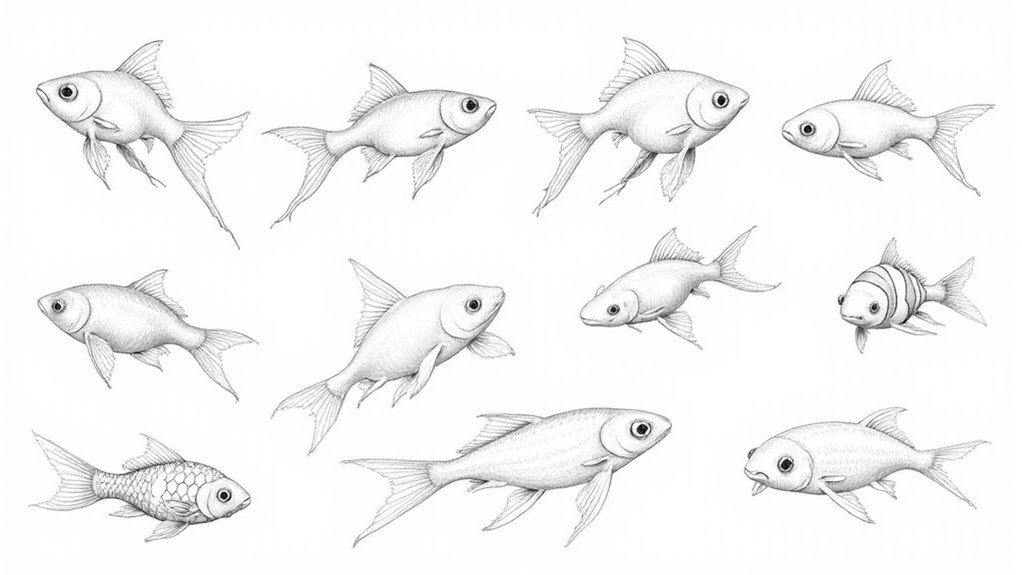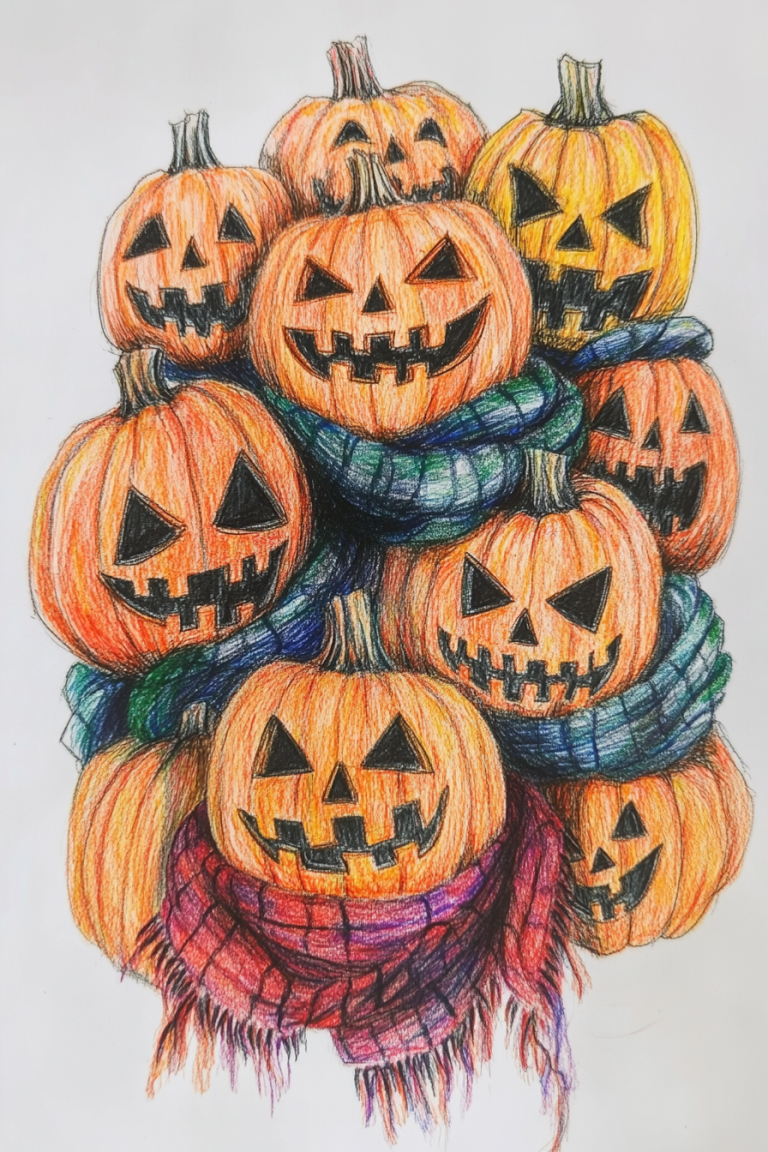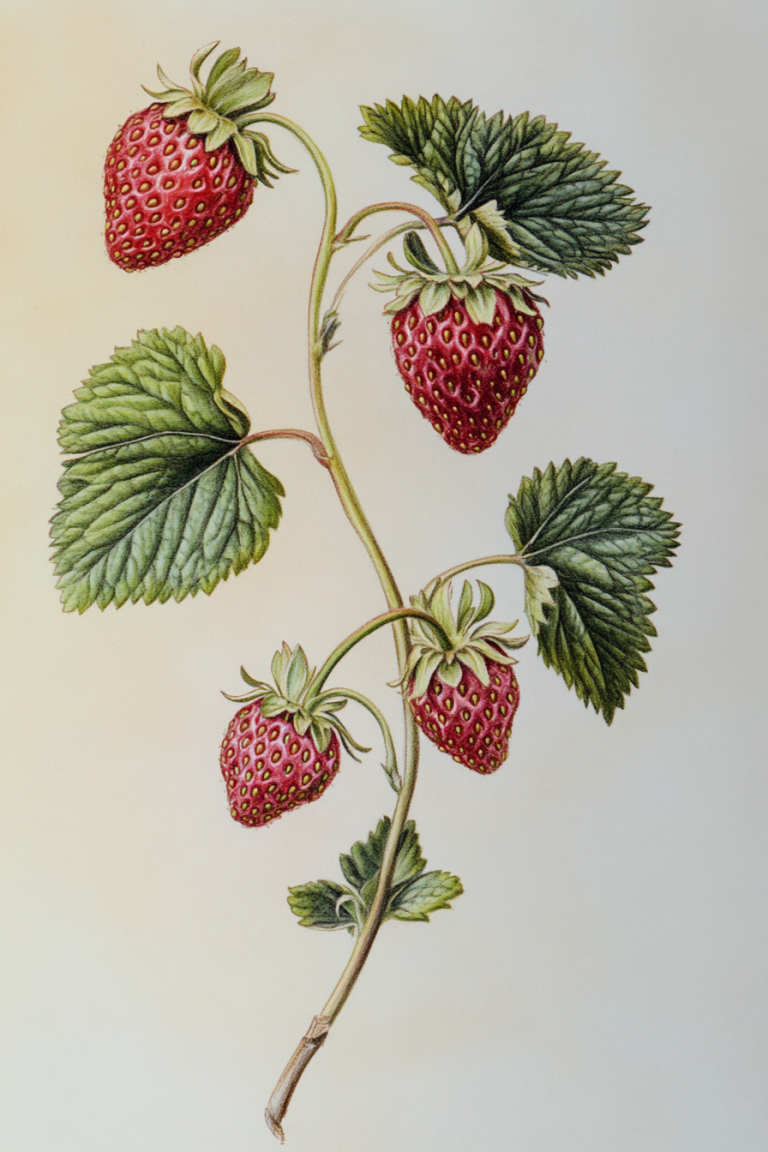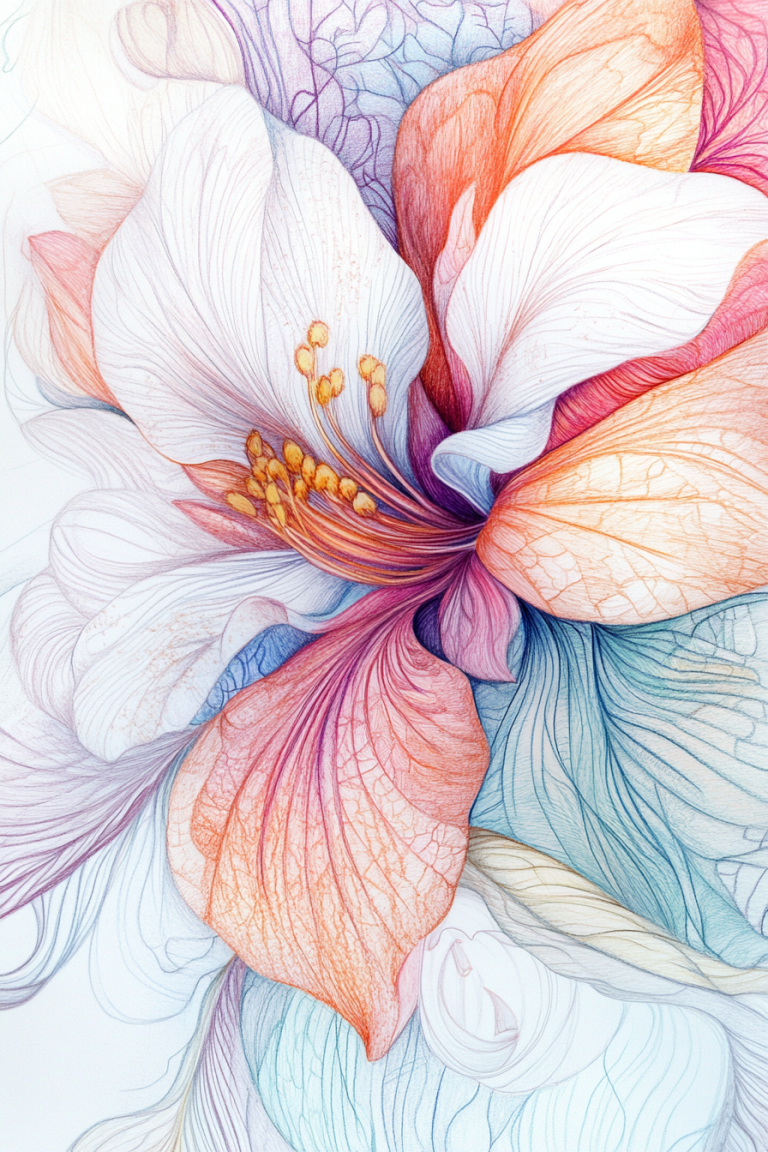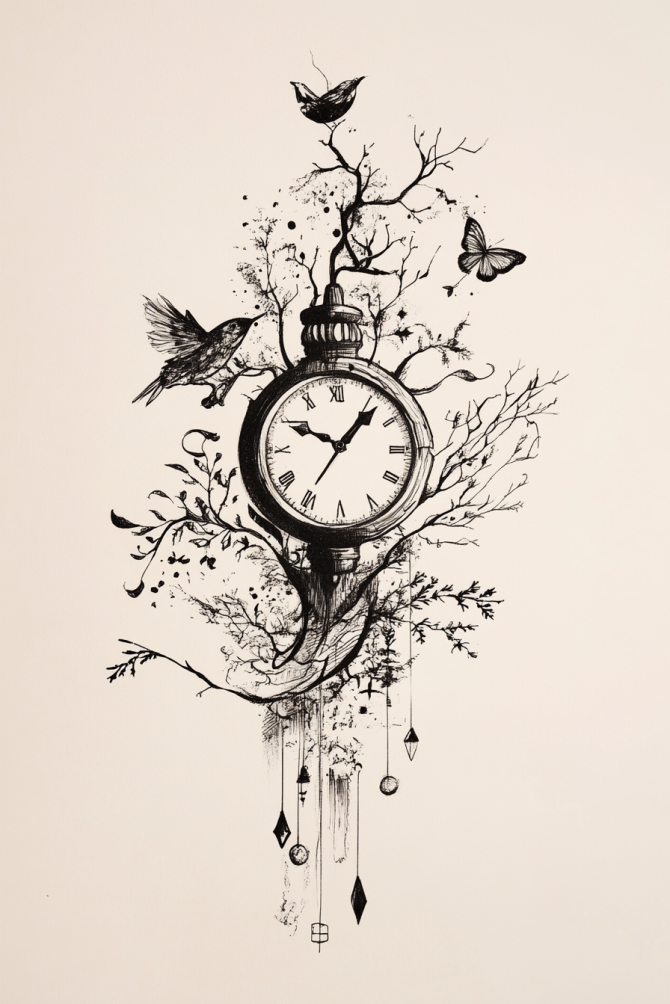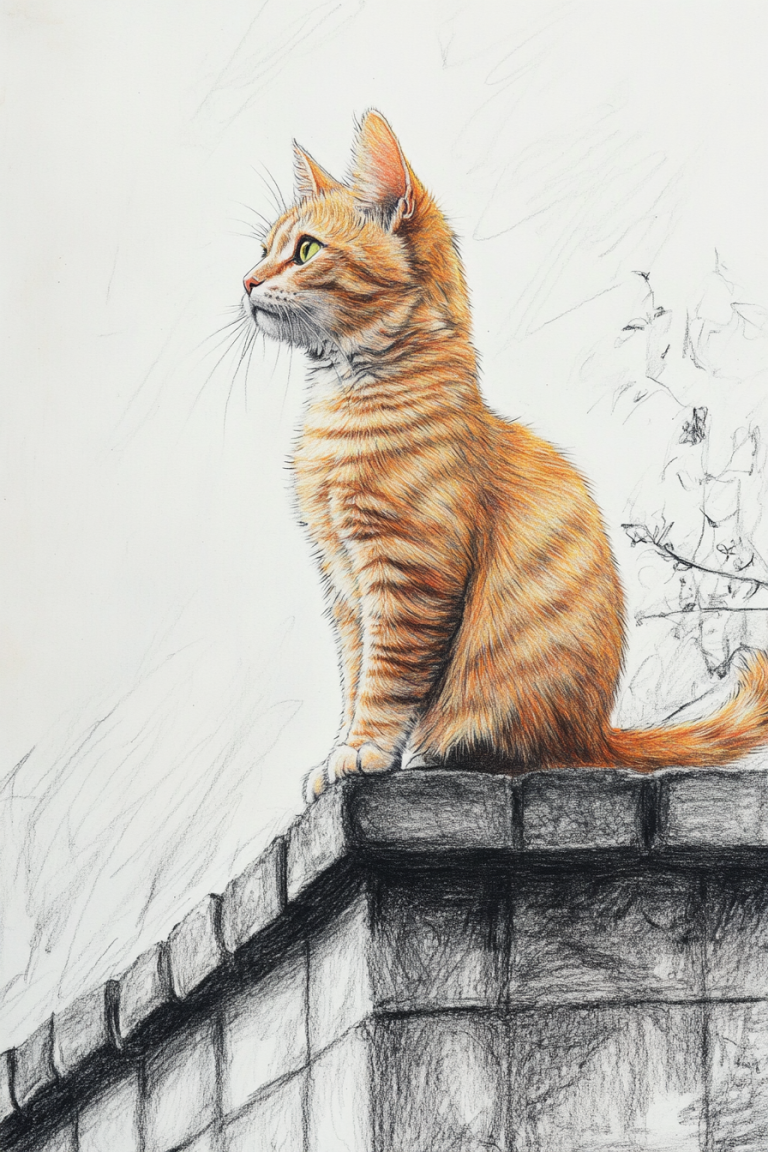17 Fish Drawing Ideas to Dive Into Your Next Artwork
If you’re looking to elevate your artistic skills, exploring diverse fish drawing ideas can be a great way to expand your creativity. From realistic goldfish in a bowl to whimsical cartoonish clownfish, there’s a wide range of styles to experiment with. Each concept offers unique challenges and opportunities to express your vision. Curious about how these ideas can transform your next artwork? Let’s explore some enchanting options that might just inspire you.
The Essentials
- Explore realistic fish drawings by capturing shimmering scales and graceful fins against dynamic backgrounds like rushing rivers or rocky terrains.
- Create stylized fish art with vibrant colors, geometric elements, and swirling lines to emphasize bold markings and flowing fins.
- Illustrate playful cartoonish fish scenes using bright colors, exaggerated features, and lively underwater settings with colorful corals and seaweed.
- Experiment with abstract and minimalist styles by focusing on exaggerated fish shapes and intricate details of bones using negative space.
- Utilize artistic techniques like monochrome drawings, varying pencil pressures, and intricate patterns to enhance depth and texture in your fish artwork.
Realistic Goldfish in a Bowl
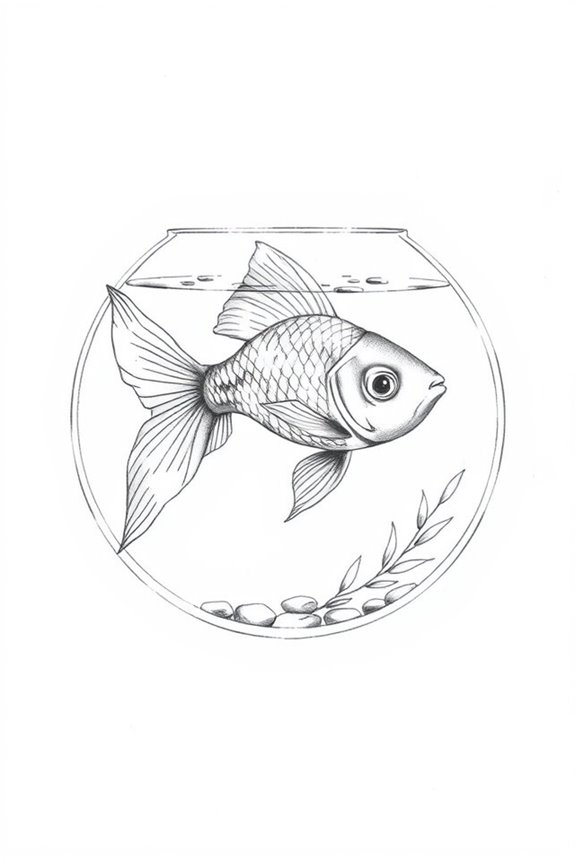
When you think about creating a realistic goldfish in a bowl, consider the intricate details that can bring your drawing to life. Focus on the shimmering scales, capturing their reflective quality with subtle highlights and shadows. Pay attention to the delicate fins, ensuring they flow gracefully as if they’re dancing in water. Don’t forget the bowl’s curvature, which distorts the view of the fish. Adding elements like pebbles or aquatic plants can give your piece depth and context. Remember to create a sense of movement; a goldfish isn’t static. With patience, your artwork will truly capture the essence of this enchanting creature. Additionally, choosing the right drawing pad type can enhance your experience and results.
Stylized Koi Fish With Intricate Patterns
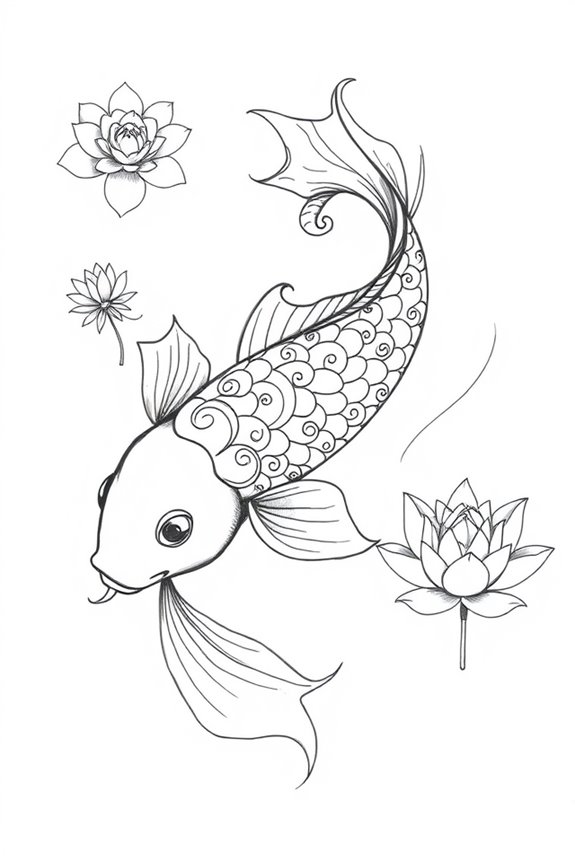
Creating stylized koi fish with intricate patterns offers a fantastic opportunity to explore vibrant colors and unique designs. You can experiment with bold outlines and flowing shapes that capture the essence of these beautiful creatures. Consider incorporating swirling lines and geometric elements to add depth and texture. Use contrasting colors to make your koi stand out against a serene background, perhaps incorporating water lilies or rippling water. Don’t be afraid to play with symmetry and asymmetry to enhance visual interest. The goal is to create a piece that reflects the grace and beauty of koi while showcasing your artistic flair. Additionally, using essential drawing pencils can help you achieve precise lines and shading in your artwork.
Cartoonish Clownfish in a Coral Reef
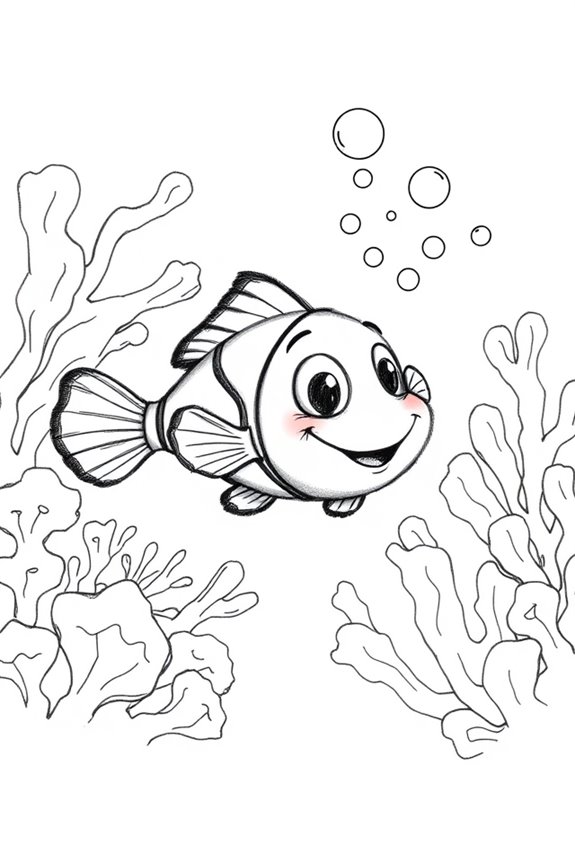
After exploring the elegance of stylized koi fish, it’s time to switch gears and have some fun with cartoonish clownfish nestled in a vibrant coral reef. Picture their bright orange and white stripes, exaggerated features, and playful expressions. You can experiment with various poses—maybe one’s peeking out from behind a coral branch or swimming joyfully among sea anemones. Don’t forget to add colorful corals and other sea creatures to create a lively underwater scene. Use bold outlines and cheerful colors to emphasize their cartoonish charm. Let your creativity flow, and enjoy bringing these whimsical fish to life! Additionally, consider using high-quality drawing pencils to capture the details and textures of your underwater adventure.
Detailed Betta Fish With Flowing Fins
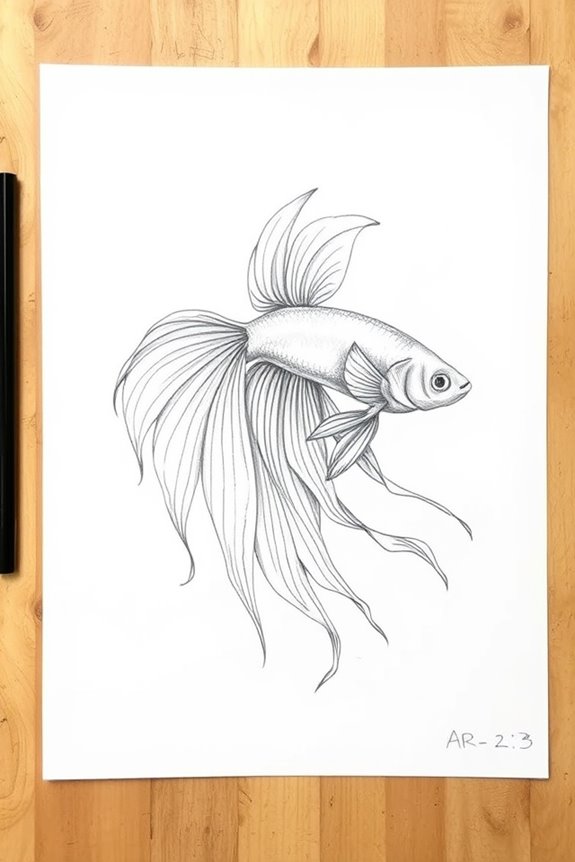
As you immerse yourself in the enchanting world of betta fish, you’ll find their flowing fins and vibrant colors make for an enthralling subject. Focus on capturing the delicate movement of their fins as they swirl gracefully. Use a variety of techniques, like layering colors to depict their shimmering scales and creating depth in their fins. Pay attention to the unique patterns and shapes that make each betta fish distinct. Experiment with different angles to showcase their beauty, and don’t forget to reflect on the background, which can enhance their allure. Engage fully, and let your creativity swim freely! Additionally, selecting the right drawing pads for your artwork can significantly impact your overall results.
Minimalist Outline of a Shark

While exploring the world of minimalist art, you’ll find that drawing a shark can be both simple and striking. Start with a smooth, curved line for the body, then add a triangle for the dorsal fin and a smaller triangle for the tail. Keep the lines clean and fluid to maintain that minimalist feel. You can use just a few well-placed strokes to suggest the shark’s distinctive features, like its pointed snout and sharp teeth, without overcomplicating the design. Using negative space effectively can also enhance your artwork, allowing the viewer’s imagination to fill in the details. Happy sketching!
Whimsical Angelfish With Decorative Elements
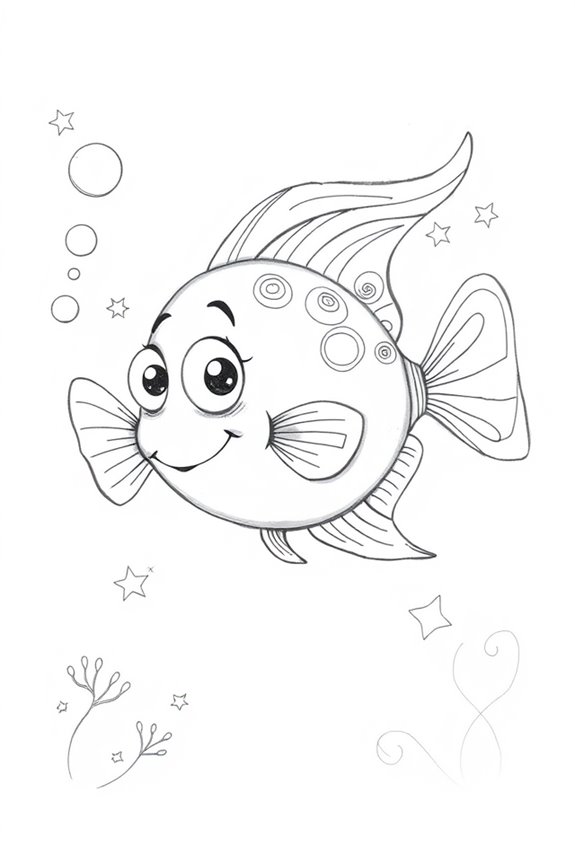
Angelfish can bring a playful charm to your artwork, especially when you add whimsical decorative elements. Think vibrant colors, flowing fins, and exaggerated features that capture their grace. You could incorporate fun patterns, like swirls or polka dots, to enhance their unique appeal. Consider adding bubbles or aquatic plants with a cartoonish twist, making the scene more lively. Don’t shy away from experimenting with unusual color combinations; it’ll make your angelfish pop. Let your imagination run wild as you design a delightful underwater world that showcases the whimsical beauty of these enchanting fish. Immerse yourself and have fun creating!
Abstract Fish Shapes and Lines

Exploring the world of abstract art can lead to fascinating interpretations of fish shapes and lines. You can experiment with exaggerated curves, sharp angles, and vibrant colors to create dynamic compositions. Think outside the box—combine different shapes to represent movement or emotion. Play with negative space to emphasize these abstract forms, allowing viewers to interpret the essence of fish in their own way. Remember, it’s not about realism; it’s about expressing your vision. Let your imagination swim freely, and don’t hesitate to blend styles or techniques. Your unique approach will make your artwork stand out in a sea of traditional representations.
Silhouette of a School of Fish
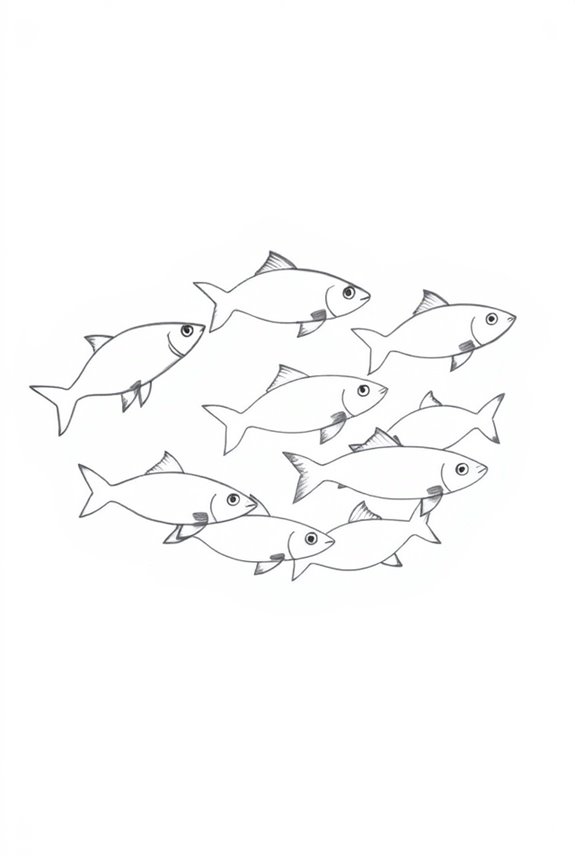
Creating a silhouette of a school of fish can be an enchanting way to convey movement and unity in your artwork. You’ll want to start by sketching the basic shapes of the fish, focusing on their streamlined bodies and fins. Keep the outlines simple; the magic lies in their collective form. Experiment with different sizes and orientations to create a dynamic composition. Once you’re satisfied, fill the shapes with a solid color or gradient that evokes the underwater world. This technique not only captures the essence of the fish but also invites viewers to appreciate the beauty of their harmony in motion.
Graphite Drawing of a Catfish

A stunning graphite drawing of a catfish can showcase its unique features and textures beautifully. Focus on the elongated body and distinctive whiskers, capturing their intricate details. Use varying pencil pressure to create depth, emphasizing the fish’s scales and fins. Start with light outlines, gradually layering darker shades for realism. Pay attention to the shadows and highlights, as they’ll bring your drawing to life. Experiment with techniques like hatching and cross-hatching to add dimension. Don’t forget the water’s surface; a subtle ripple effect can enhance the overall composition. With patience, you’ll create a mesmerizing representation of this fascinating fish!
Vintage Illustration of a Pufferfish
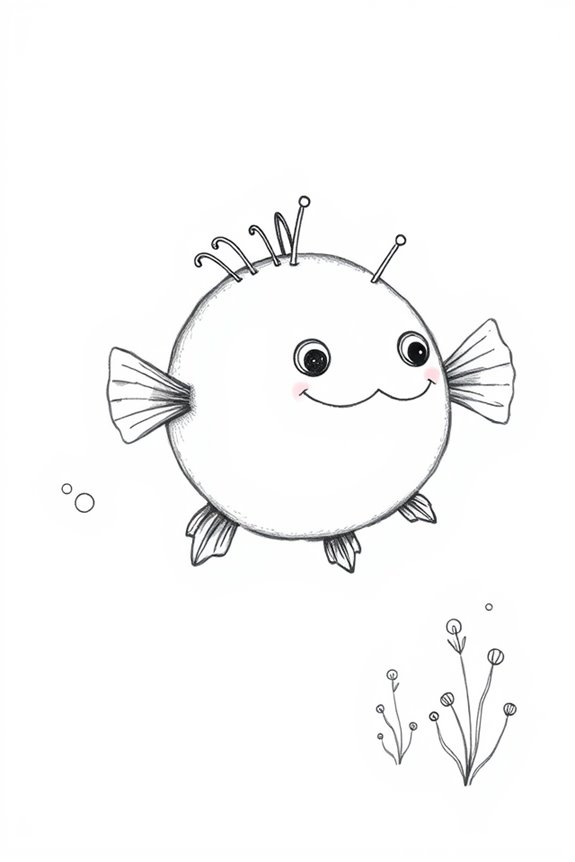
There’s something enchanting about vintage illustrations of pufferfish, capturing their quirky shape and intricate patterns. When you immerse yourself in this style, you’ll appreciate the delicate lines and textures that bring these fascinating creatures to life. Consider using muted colors reminiscent of old prints, which can evoke a sense of nostalgia. Pay attention to the unique features, like their spiny skin and bulging eyes, as you sketch. Don’t hesitate to experiment with different angles or add whimsical elements to enhance your composition. By embracing the charm of vintage illustrations, your artwork will surely stand out and captivate viewers.
Lively Salmon Jumping Upstream
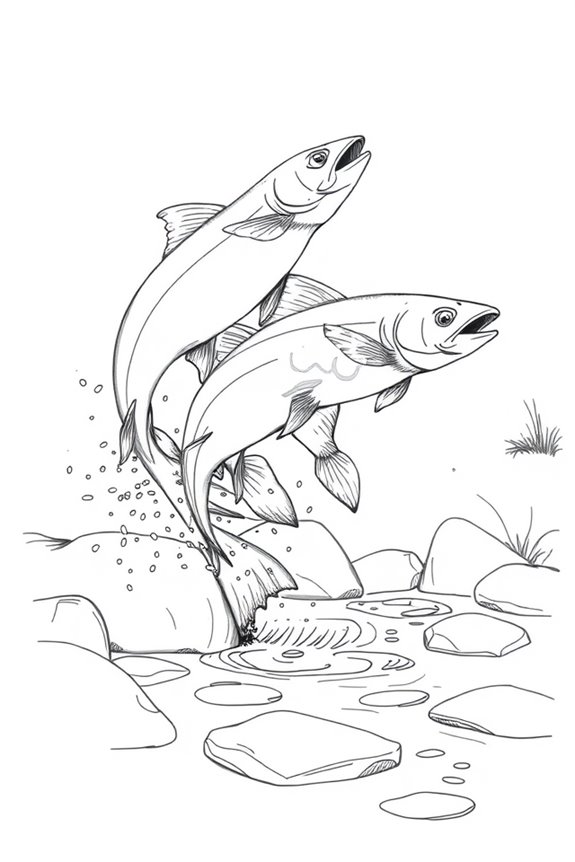
Vintage illustrations have their own charm, but capturing the dynamic energy of a lively salmon jumping upstream offers a different kind of excitement. When you draw this scene, focus on the movement and fluidity of the fish. Use sweeping lines to convey its leap, and add splashes of water to emphasize the action. Experiment with colors—vibrant pinks and silvers can bring the salmon to life. Pay attention to the background, too; a rushing river or rocky terrain can enhance the sense of struggle. With each stroke, aim to evoke the thrill of nature’s journey and the salmon’s relentless spirit.
Ornate Tropical Fish With Exotic Features
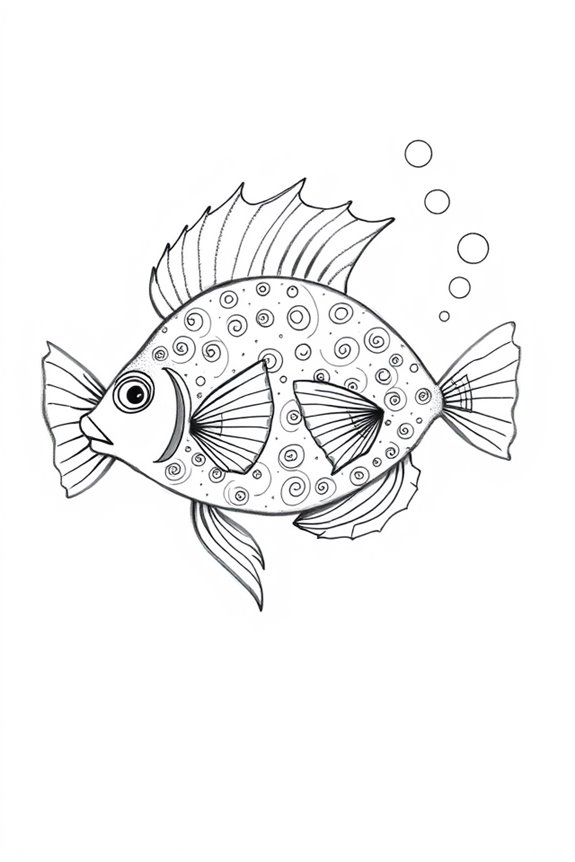
Ornate tropical fish enchant with their vibrant colors and unique features, offering a stunning subject for your drawings. You’ll find inspiration in their intricate patterns and exotic shapes. Consider focusing on the delicate fins that flutter like silk, or the bold markings that create mesmerizing contrasts. Experiment with bright hues like electric blues, fiery oranges, and vivid yellows to bring your artwork to life. Pay attention to the fish’s enchanting eyes, often adorned with shimmering scales. By capturing their beauty, you’ll not only enhance your skills but also create an artwork that reflects the vivid underwater world. Immerse yourself!
Fish Skeleton for a Unique Perspective
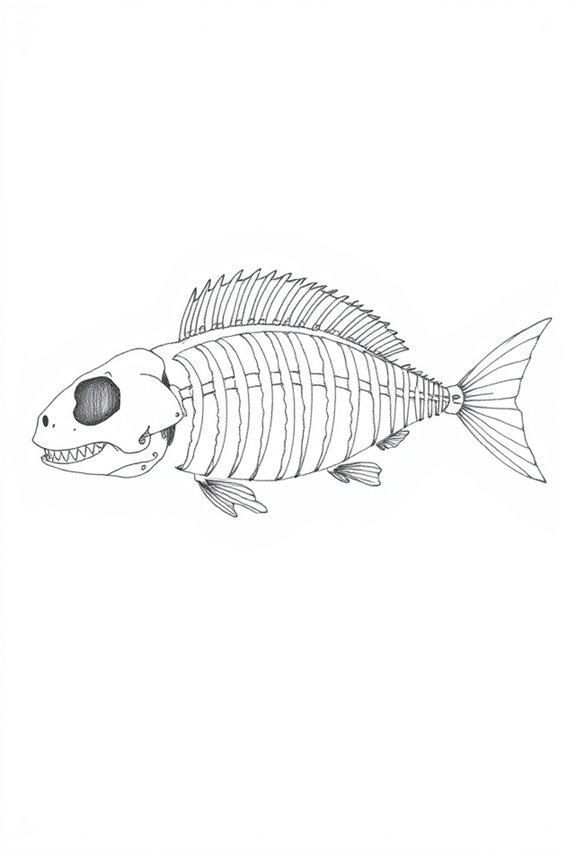
While many artists focus on the vibrant exterior of fish, exploring the structure of a fish skeleton provides a unique and enthralling perspective. You’ll find that the intricate details of bones and cartilage create fascinating shapes and lines. Consider using a variety of angles to capture the fluidity of the skeleton’s design. Experiment with shading to highlight the contrast between the delicate bones and empty spaces. This approach not only challenges your skills but also encourages you to appreciate the beauty in what’s often overlooked. Let the skeleton inspire your creativity and add a new dimension to your fish drawings.
Playful Fish Swimming Through Seaweed
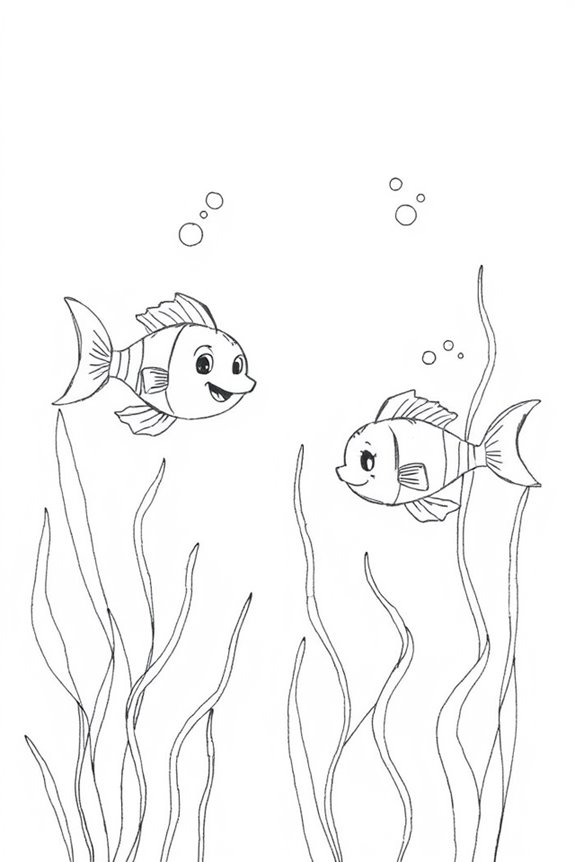
After exploring the intricate beauty of fish skeletons, it’s time to shift focus to the lively world of playful fish swimming through seaweed. Imagine vibrant colors splashing against the backdrop of flowing green tendrils. You can capture their joyful movements as they dart through the swaying seaweed, creating a sense of rhythm in your artwork. Experiment with varying shades of blue and green to convey depth and light. Consider using playful lines and curves to depict their lively antics. This scene allows your creativity to flourish, inviting observers to feel the carefree essence of underwater life. Immerse yourself and let your imagination swim!
Monochrome Drawing of a Swordfish

Although the swordfish is renowned for its sleek form and impressive bill, creating a monochrome drawing of this magnificent creature can reveal its striking features in a new light. By focusing on shades of gray, you can emphasize its streamlined body and angular fins, showcasing the elegance of its design. Use varying pencil pressures to create depth, capturing the texture of its skin. Shadows can bring out the contours, while highlights can make the bill pop. Experiment with different techniques like cross-hatching or stippling to add complexity. This approach not only highlights the swordfish’s beauty but also enhances your artistic skills.
Intricate Mandala Fish Design

Creating an intricate mandala fish design allows you to blend creativity with the calming patterns typical of mandalas. Start by sketching a basic fish shape, then fill it with geometric and flowing patterns. Use circles, spirals, and lines to create harmony within the design. Consider varying the thickness of the lines to add depth and interest. You can experiment with different styles, like adding scales or fins adorned with mandala elements. Once you’re satisfied, bring your design to life with colors that resonate with you, making it a personal and meditative experience. Immerse yourself, and let your imagination swim free!
Fantasy Fish With Mythical Attributes
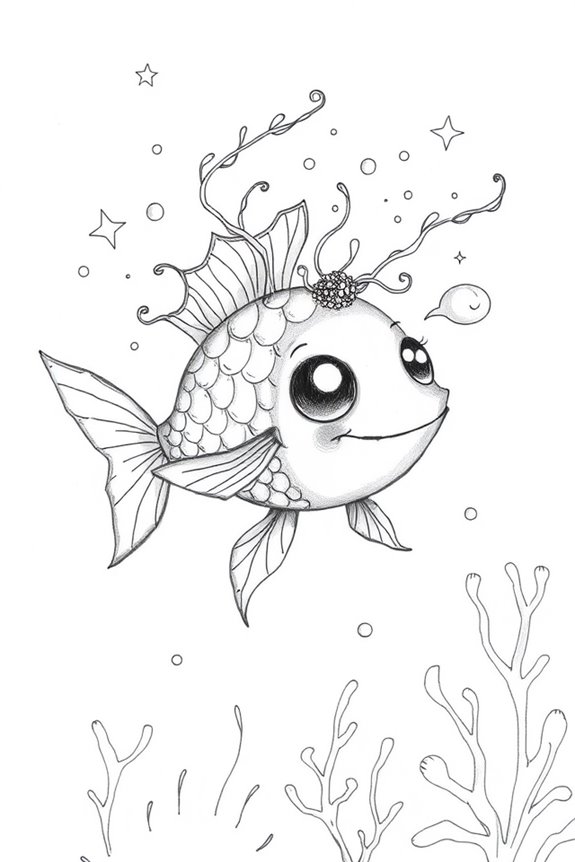
When you plunge into the domain of fantasy fish with mythical attributes, you’ll discover a sphere where imagination knows no bounds. Picture vibrant scales that shimmer like gemstones and fins that flow like silk. You might envision a fish with wings, soaring through the sky, or one adorned with glowing patterns that change with its mood. Consider adding enchanting features like a crown of coral or bioluminescent spots that light up the depths. Let your creativity run wild, combining elements from various myths. These fantastical creations can inspire awe, inviting viewers to immerse themselves in the magic of your artistic world.
Frequently Asked Questions
What Materials Are Best for Drawing Fish?
For drawing fish, you’ll want to use high-quality pencils for detail, watercolors for vibrant colors, or markers for bold outlines. Don’t forget good paper to enhance texture and bring your creations to life!
How Can I Improve My Fish Drawing Skills?
To improve your fish drawing skills, practice regularly, study real fish for reference, and experiment with different techniques. Don’t hesitate to seek feedback from others and explore various styles to enhance your creativity.
Are There Specific Techniques for Drawing Fish Scales?
Yes, to draw fish scales, use small, overlapping arcs or ovals. Vary your pressure for depth and texture. Consider shading to create dimension, and study real fish for realistic patterns and scale placement.
What Fish Species Are Easiest for Beginners to Draw?
Goldfish, bettas, and guppies are great fish species for beginners to draw. Their shapes are simple, and their colors can inspire creativity. Plus, they’re commonly found, making reference images easy to find and study.
How Can I Add Color to My Fish Drawings?
You can add color to your fish drawings by using colored pencils, watercolors, or markers. Experiment with blending techniques and vibrant hues to bring your artwork to life, enhancing the fish’s natural beauty and details.

